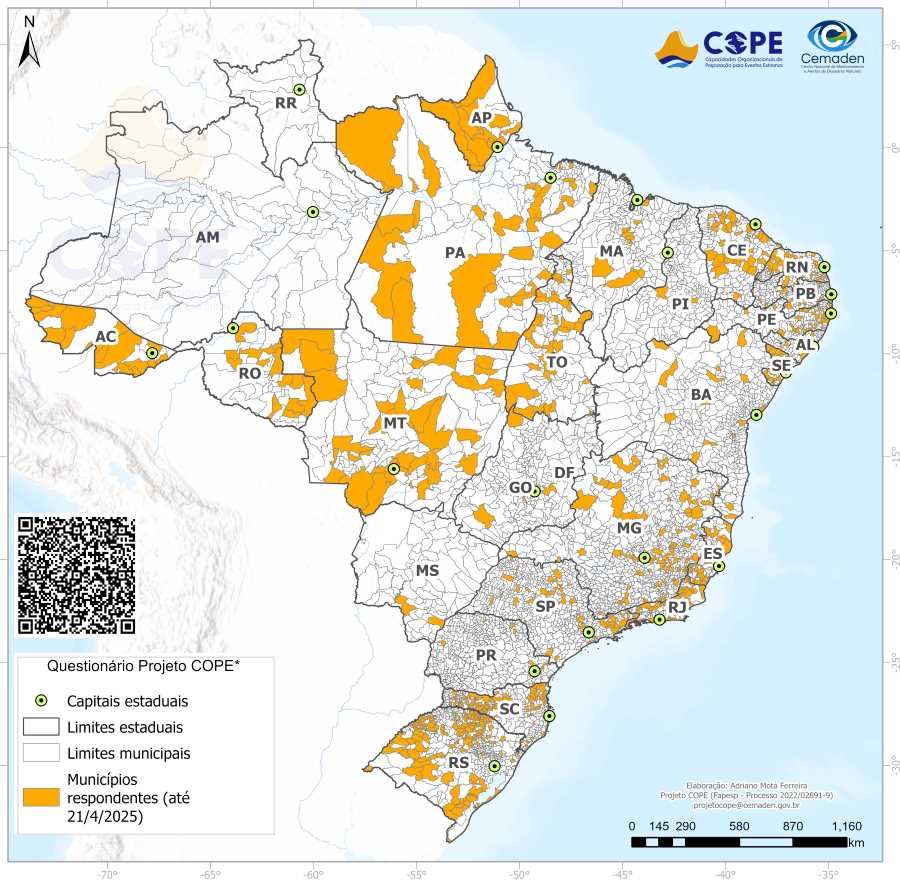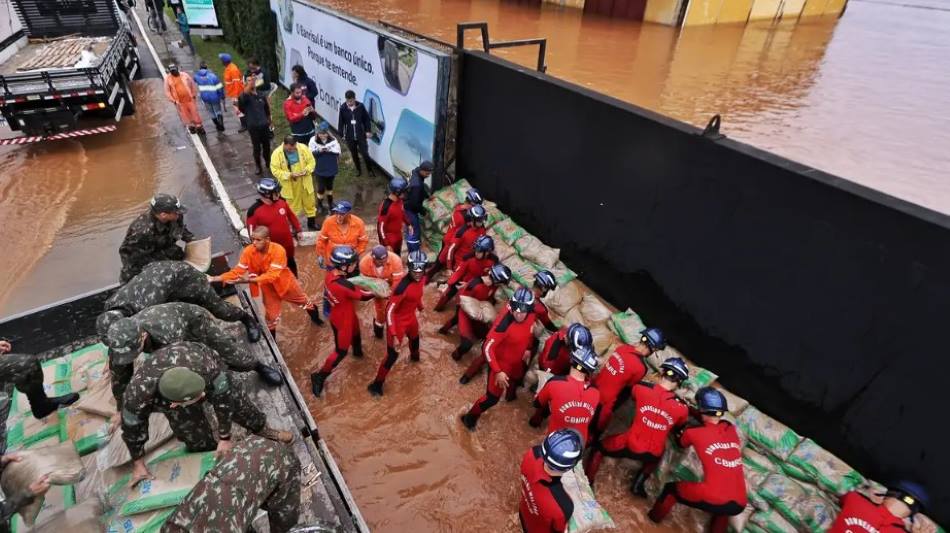Summary:
As climate-related disasters grow more severe and frequent across Brazil, a new study highlights urgent gaps in the ability of municipal civil defense units to respond effectively. The research, led by scientists at the Brazilian National Center for Monitoring and Early Warning of Natural Disasters (CEMADEN), emphasizes that strengthening the organizational capacity of these units is critical, not only for responding to emergencies but also for proactive prevention and risk mitigation.
The study has been published in the International Journal of Disaster Risk Reduction.
Drawing on data from nearly 2,000 municipalities, in-depth interviews, and focus groups, the authors propose five core strategies to bolster civil defense systems: professionalizing staff; tailoring training to regional and biome-specific challenges; allocating dedicated municipal budgets; ensuring constant communication across government levels; and promoting broader social and cross-sectoral participation.
The report paints a concerning picture: most civil defense units face serious resource constraints, lack proper training, and operate without essential tools like early warning systems or inventories of at-risk populations. These limitations leave communities more vulnerable to the impacts of floods, landslides, and other climate-related hazards. The study proposes a set of actionable policies to support national disaster frameworks and help municipalities build resilience from the ground up.

Civil defense units must invest in professionalization and own resources to face climate risks
As the effects of climate change intensify in urban areas, it is essential to strengthen the organizational capacity of civil defense units to implement disaster risk management, including prevention and mitigation. To contribute to this debate, a study conducted by researchers from the Brazilian National Center for Monitoring and Early Warning of Natural Disasters (CEMADEN) proposes a public policy focused on five fronts.
These are:
1) professionalization of managers and officials in the area;
2) development of capacities adapted to regional specificities and to each biome;
3) allocation of their own budget to municipalities;
4) continuous communication; and
5) social and intersectoral participation.
These actions were designed to address the main challenges identified by the municipal civil defense units themselves in the implementation of the policy. Among these obstacles are difficulties in monitoring and supervising urban expansion in areas prone to flooding and landslides, reduced teams, as well as a lack of professionalization, financial resources, social participation and relationships with other administrative areas.
The research used quantitative and qualitative data collected through mixed methods between October 2020 and December 2021. It included an online questionnaire completed by 1,993 of Brazil’s 5,568 municipalities, interviews with 31 city representatives from five regions of Brazil and ten virtual focus groups with 260 participants.
Some 43% of those interviewed considered themselves poorly qualified to act before a disaster strikes, a level similar to that for acting during (40%) and after (41%) the event. Although more than half say they are capable or very capable of assessing and reporting material damage (60%), identifying and mapping risk areas (54%) and keeping the population informed (53%), 61% do not use an early warning system and 54% do not conduct an inventory of people living in risk areas.
The work also brings together previous findings from the ELOS project – a diagnosis of the needs and capacities of municipal civil defense units carried out from 2021 – and goes one step further, focusing on thinking about solutions to the problems. Part of the quantitative data from ELOS resulted in six publications of the Municipal Diagnosis of Civil Protection and Defense.
“The intensification of extreme weather events has led to an increase in the area affected by disasters, going beyond municipal territory and even river basins. In the state of Rio Grande do Sul, for example, 96% of municipalities were affected or devastated by floods and landslides in May 2024, prompting the state and other organizations to rethink their approach. In Brazil, we usually mobilize when disaster strikes. But we need to prepare better and think about how to improve coordination between the different administrative bodies and society before the disaster so that the response isn’t always improvised,” says CEMADEN researcher Victor Marchezini, corresponding author of the article and coordinator of ELOS.
According to the Digital Atlas of Disasters in Brazil, a National Civil Defense platform, between 2014 and 2024, the country recorded about 11,400 incidents of floods, flash floods, heavy rains, tornadoes, storms, cyclones, hail and mass movements. A total of 63 million people were affected during the decade.
The scientists are now working on new data collection with municipal civil defense units, which will run until July 1st, focusing on prevention, as part of the Organizational Capacities for Preparing for Extreme Events (COPE) project. By April 21st, about 1,000 Brazilian municipalities had completed the COPE-CEMADEN project questionnaire.
Aspects of risk mapping, warning systems, the relationship with other bodies in the municipality and with different social groups and how they deal with risk management instruments are being explored. There are questions about the relationship with municipal climate change adaptation plans, fake news and information shared with the press. The form for public managers and civil defense personnel can be accessed here.
“Brazilian disaster risk management policies have assigned responsibilities to local governments without assessing whether they have the organizational capacity to make decisions and coordinate with other actors. We’ve seen that insufficient financial and personnel resources and the high turnover of employees, who don’t always receive adequate training, have a direct impact on this reality,” Marchezini, COPE’s coordinator, told Agência FAPESP.
***
Interdisciplinary
The recently published research was supported by FAPESP through a scholarship awarded to Marchezini and a grant for the funding of COPE.
In addition to analyzing the organizational capacities of civil defense units, COPE aims to co-produce strategies to strengthen the implementation of public policies, integrating teaching, research and extension activities and connecting public managers and communities exposed to disaster risks.
Throughout their work, the researchers identified gaps in ways to strengthen social participation in risk management, especially when it comes to involving affected communities and other sectors, such as the private sector.
To seek alternatives, in 2024 the group conducted a survey on the perception of risk communication with 5,000 respondents in all Brazilian states. The data are currently being analyzed.
In the study, the group assesses that there is room for future work to examine how public and private organizations can improve their capacity to deal with hazards and vulnerabilities and the new societal challenges associated with disinformation.
Journal Reference:
Victor Marchezini, Silvia Midori Saito, Luciana R. Londe, Fernanda Dalla Libera Damacena, ‘Implementation challenges of disaster risk management policies: The organizational capacities of municipal civil defense units’, International Journal of Disaster Risk Reduction 119, 105291 (2025). DOI: 10.1016/j.ijdrr.2025.105291
Article Source:
Press Release/Material by Fundação de Amparo à Pesquisa do Estado de São Paulo (FAPESP)
Featured image credit: Lauro Alves | Secom-RS




